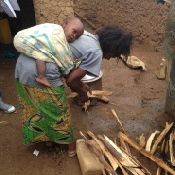Playing It SAFE: Integrating Energy Into Humanitarian Initiatives
Aid agencies have always given priority to helping people meet their “basic needs” of food, water, shelter and clothing, but one crucial element is often missing from the list: energy. Needed for cooking, lighting, heating, and power, it’s finally starting to get the attention it deserves within the humanitarian community.

19 November 2014 | In May of this year, the Office of the United Nations High Commissioner for Refugees (UNHCR) announced its global strategy for Safe Access to Fuel and Energy (SAFE). The announcement marked the culmination of years of work across UN agencies and non-profits to bring attention to the risks women are forced to take when finding fuel for cooking, lighting, and heating.

Mother cooking on cookstove in Kigeme refugee camp, Rwanda
© Katherine Arnold, Global Alliance for Clean Cookstoves.
In humanitarian settings, uncooked food is distributed to refugees and internally displaced people. It falls upon women and children, particularly girls, to find fuel to cook this food sometimes walking up to 10-20 kilometers to find firewood. These needs first started to be addressed 15 years ago. The Sphere Handbook, a guide with minimum standards for humanitarian implementers, was released in 2000 and updated in 2004 and 2011. The handbook identified access to safe and efficient cookstoves, fuels, and lighting as integral to any humanitarian response.
Until 2007, there was no designated group working to encourage humanitarian organizations to comply with these cooking and lighting standards. As a result, these issues languished and refugees, internally displaced persons, and other crisis-affected populations suffered.
In response, organizations such as the UN Refugee Agency, Women’s Refugee Commission (WRC), UN World Food Programme (WFP), and others, collaborated to form the SAFE Steering Committee, which the Global Alliance for Clean Cookstoves (Alliance) and WRC co-chair.
UNHCR’s announcement of its Global SAFE Strategy is the first big step towards implementation. “The UNHCR strategy formally commits and binds the organization to address these issues instead of having individual projects that are tested for a couple years and then fall off the radar, said Megan Gerrard, Senior Gender-based Violence Prevention Officer at WRC.
The focus now is on developing cohesive strategies, she said. “There have been enough pilot projects that we don’t need to keep reinventing the wheel. We know more or less what has worked well and what has not. We’re really trying to scale up.
Training to be SAFE
Acquiring resources and scaling up training and implementation is the next big challenge.
The Alliance and WRC began tackling the training needs in June, when they teamed up with UNHCR for a SAFE 101 training. The training attracting a mix of UN, non-profit, government, and private sector staff focused on practical, on-the-ground applications and best practices.
For the first two days of training, participants spent time indoors learning how to implement SAFE projects, where to find resources, and best practices for East African humanitarian settings. They then visited refugee camps to see examples of SAFE projects in action.
“We wanted to really prioritize national staff this time around because they are the ones overseeing work on a day-to-day basis and working with the communities in and around the camps, Gerrard said.
Many of the local participants lack funding and resources so the Alliance helped cover event costs and travel for almost all of the 65 participants who attended from 15 countries. Eventually, scaling up implementation will mean that humanitarian programs yearly budgets and proposals must prioritize SAFE, so future trainings may include guidance on grant-writing and developing fundraising strategies.
Gerrard doesn’t expect overnight implementation. “The humanitarian community typically adapts to change very, very slowly largely because of the complexity of the environments we’re working in, she explained.
UNHCR will finalize national energy and environment strategies for five countries in 2014: Rwanda, Kenya, Ethiopia, Chad, and Burkina Faso. These countries will then begin implementation in early 2015, and the plans intend to take each country through until 2018. Four more countries will develop national strategies during 2015, for implementation beginning in 2016.
With the latest tracked humanitarian activities in the Alliance’s 2013 Results Report, one-third of the 29 humanitarian projects described utilizing the WFP handbook, which provides guidance on SAFE project planning and monitoring and evaluation, or other SAFE resources. An additional 19 cookstove and fuel projects reported through the SAFE Steering Committee’s online project database representing approximately 400,000 households that were provided with cleaner stoves and fuel in nine countries.
“It’s exciting to see the progress we’ve made on SAFE in the past year, said Corinne Hart, Director of Gender and Humanitarian Programs at the Global Alliance for Clean Cookstoves. “Our work on the SAFE Steering Committee and UNHCR’s new global strategy has sparked interest on the issue of safe access to fuel and energy for humanitarian populations, and I think the global community is starting to realize that this is an urgent and overlooked problem that needs to be addressed.
For more information, please visit the recently launched SAFE website at www.safefuelandenergy.org.
Kelley Hamrick is an Associate in Ecosystem Marketplace’s Carbon Program. She can be reached at [email protected].
Please see our Reprint Guidelines for details on republishing our articles.


